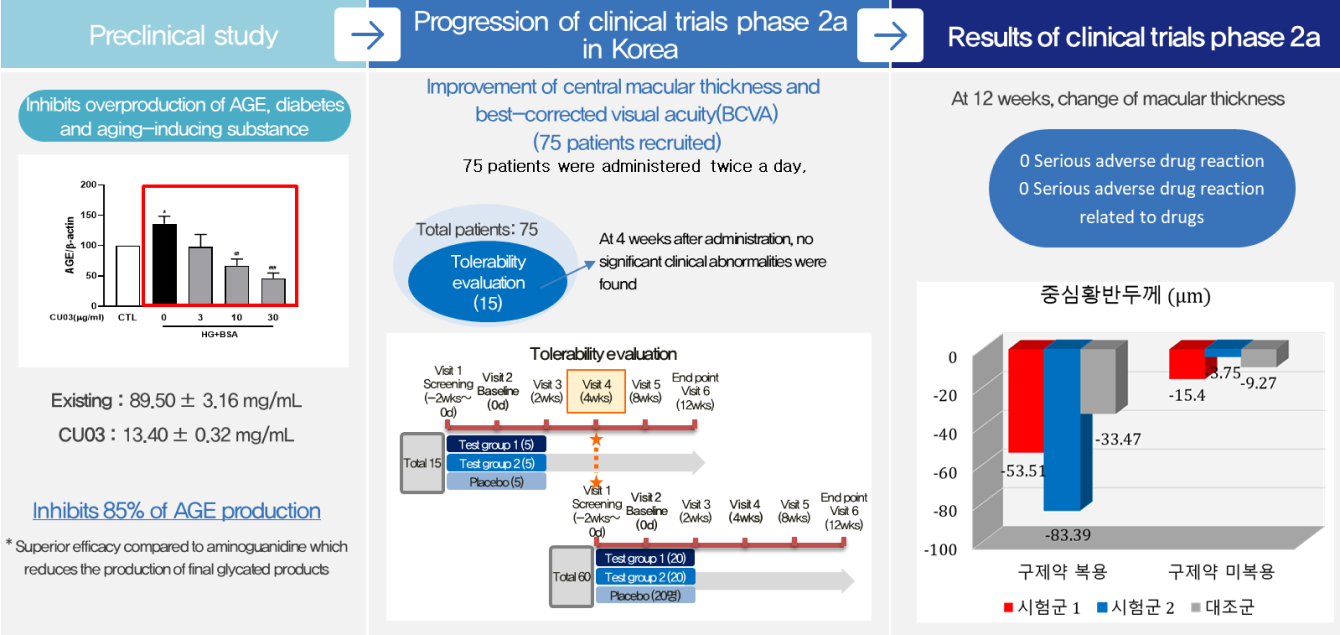Pipeline
cu03
Pipeline
cu03
CU03
Orally administered treatment for age-related macular degeneration(AMD)
| 구분 | 내용 |
|---|---|
| CU03 | Orally administered treatment for age-related macular degeneration(AMD) • CU03, a natural herbal medicine, is a mixture of cinnamon twig extract and moutan root bark extract. • Combination therapy with anti-VEGF - Increase overall efficacy - Reduce the frequency of anti VEGF injection • Orally available - An oral drug which is easy to take and can be used to treat a wide range of patients from mild to severe patients receiving antibody therapy. - Increase convenience and compliance |
| Indication | • Wet AMD (Age-related macular degeneration) |
| Unmet Needs | • Existing treatment is an anti-VEGF-based antibody treatment. expensive medical expenses and limitation in insurance benefits • 15 ~ 20% of total patients are non-responsive to anti-VEGF therapy. • Limitations and side effects of the underlying treatment such as eye pain, retinal hemorrhage, retinopathy, increased intraocular pressure, severe bleeding, and delayed wound healing • Risk of inflammation, pain and fear from intraocular injection |
| Mechanism of Action | • The mechanism by which CU03 exerts its therapeutic effect in AMD is anti-inflammation, anti-angiogenesis and anti-oxidation. |
| Efficacy & Safety | • In the prevention or treatment of macular degeneration caused by the imbalance of proteolytic action, the mixture of cinnamon twig extract and moutan root bark extract was confirmed to have excellent efficacy in inhibiting the production of final glycated products in retinal pigment epithelial cells. • The anti-angiogenesis effect has been proven in a laser-induced choroidal neovascularization rat model. • A polyphenol structure present in multi-components of CU03 is also well known to have antioxidative and anti-inflammatory effect. |
Indication
Wet AMD (Age-related macular degeneration)
• Macular degeneration, the main cause of blindness in the elderly
• The burden of expensive medical expenses
• Limitations and side effects of fundamental treatment
• Risk of inflammation due to intraocular injection, pain, and fear
Wet AMD (Age-related macular degeneration)
• Macular degeneration, the main cause of blindness in the elderly
• The burden of expensive medical expenses
• Limitations and side effects of fundamental treatment
• Risk of inflammation due to intraocular injection, pain, and fear
Unmet Needs
• Existing treatment is an anti-VEGF-based antibody treatment.
→ expensive medical expenses and limitation in insurance benefits
• 15 ~ 20% of total patients are non-responsive to anti-VEGF therapy.
• Limitations and side effects of the underlying treatment such as eye pain, retinal hemorrhage, retinopathy, increased intraocular pressure, severe bleeding, and delayed wound healing
• Risk of inflammation, pain and fear from intraocular injection
• Existing treatment is an anti-VEGF-based antibody treatment.
→ expensive medical expenses and limitation in insurance benefits
• 15 ~ 20% of total patients are non-responsive to anti-VEGF therapy.
• Limitations and side effects of the underlying treatment such as eye pain, retinal hemorrhage, retinopathy, increased intraocular pressure, severe bleeding, and delayed wound healing
• Risk of inflammation, pain and fear from intraocular injection
Mechanism of Action
The mechanism by which CU03 exerts its therapeutic effect in AMD is anti-inflammation, anti-angiogenesis and anti-oxidation.
In the prevention or treatment of macular degeneration caused by the imbalance of proteolytic action, the mixture of cinnamon twig extract and moutan root bark extract was confirmed to have excellent efficacy in inhibiting the production of final glycated products in retinal pigment epithelial cells.
The anti-angiogenesis effect has been proven in a laser-induced choroidal neovascularization rat model.
A polyphenol structure present in multi-components of CU03 is also well known to have antioxidative and anti-inflammatory effect.
The mechanism by which CU03 exerts its therapeutic effect in AMD is anti-inflammation, anti-angiogenesis and anti-oxidation. In the prevention or treatment of macular degeneration caused by the imbalance of proteolytic action, the mixture of cinnamon twig extract and moutan root bark extract was confirmed to have excellent efficacy in inhibiting the production of final glycated products in retinal pigment epithelial cells. The anti-angiogenesis effect has been proven in a laser-induced choroidal neovascularization rat model. A polyphenol structure present in multi-components of CU03 is also well known to have antioxidative and anti-inflammatory effect.
Efficacy


Safety
Safety was secured in the 13-week non-clinical GLP toxicity test, genotoxicity and safety pharmacology test.
There were no significant parameter changes for CNS, Cardiovascular, Respiratory system after administration of CU03 in animal models
The two components of CU03 have been prescribed in oriental medicine for a long time and they are listed in the Korean Pharmacopoeia and the Standards of Herbal Medicine.
Safety was secured in the 13-week non-clinical GLP toxicity test, genotoxicity and safety pharmacology test. There were no significant parameter changes for CNS, Cardiovascular, Respiratory system after administration of CU03 in animal models The two components of CU03 have been prescribed in oriental medicine for a long time and they are listed in the Korean Pharmacopoeia and the Standards of Herbal Medicine.